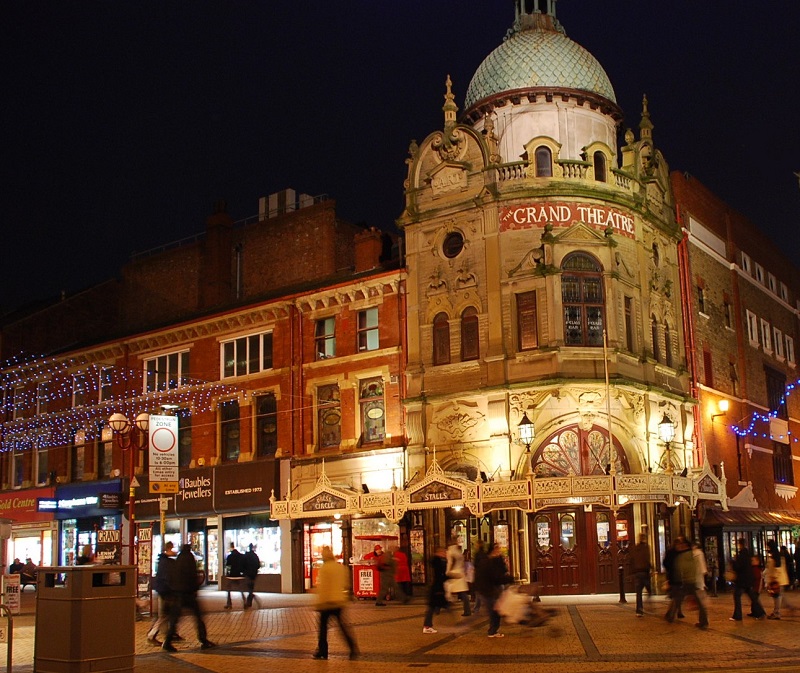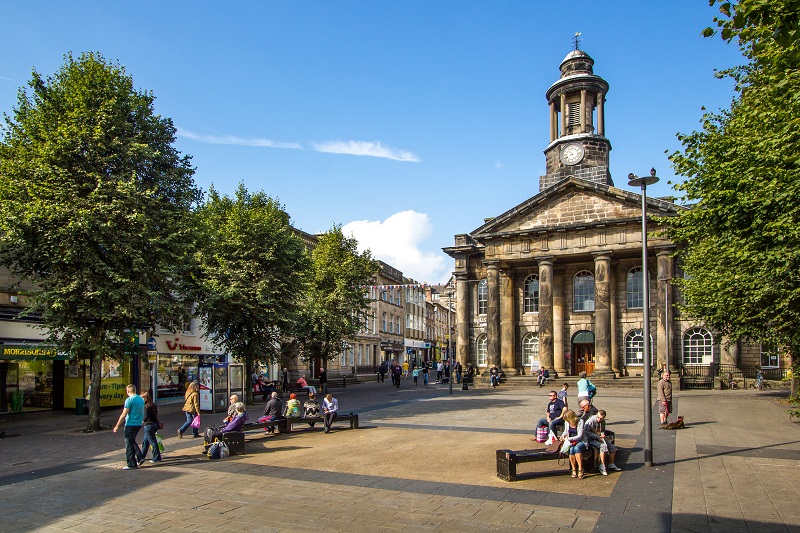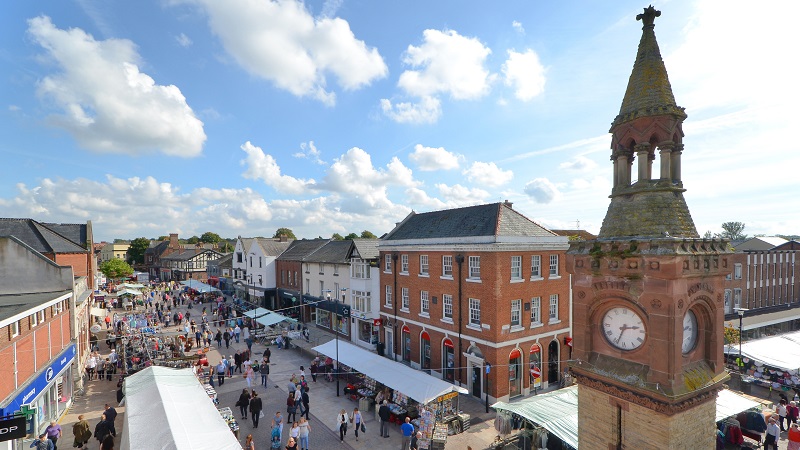From Blackpool to Bacup funding secured for historic high streets recovery

From Blackpool to Bacup, 14 historic high streets across the North West have been offered government funding to give them a new lease of life and help them recover from declining footfall and the impact of the COVID-19 pandemic. The £95m government-funded High Streets Heritage Action Zone (HSHAZ) programme, which is delivered by Historic England, will unlock the potential of these high streets, fuelling economic, social and cultural recovery.
The lead partners for the schemes (mostly local authorities) are working with Historic England to develop and deliver schemes that will transform and restore disused and dilapidated buildings into new homes, shops, workplaces and community spaces, restoring local historic character and improving public realm.
The High Streets Heritage Action Zone initiative in England is funded with £40 million from the Department for Digital, Culture Media and Sport’s Heritage High Street Fund and £52 million from the Ministry of Housing, Communities and Local Government’s Future High Street Fund. A further £3 million will be provided by the National Lottery Heritage Fund to support a cultural programme. Historic buildings on our high streets give great character to local towns and cities, making each distinctive and appealing to people. Up to 48% of the nation’s retail stock was built before 1919 and the loss of business occupiers in these historic buildings is placing them at risk and undermining the character, local identity and viability of the high street.

The HSHAZ scheme includes £7.4 million to fund four years of cultural activities across the country to engage communities with their local high streets, and celebrate the role and importance of these historic areas as hubs of the community. The Cultural Programme is led by Historic England, in partnership with The National Lottery Heritage Fund and Arts Council England.
The money will fund two arms of the programme, the first is grants distributed through cultural consortia set up by Local Authority partners. These consortia will work with artists and creative organisations local to the high streets to develop their ideas and deliver activity.
The second part of the programme is a series of national cultural commissions. Historic England is asking creatives to respond to briefs that include capturing the everyday spirit of high streets, and connecting high streets across the country; this will include a large-scale outdoor arts celebration of the high street and a four year photography commission to document the changing face of the high street. Further commissions will be announced in each year of the cultural programme.

Catherine Dewar, North West Regional Director at Historic England, said: “Our high streets bring people together. They are places to socialise, shop, run businesses and be part of our local community. Every high street across the North West has a distinctive history that can be harnessed to help it achieve a prosperous future.
“Investing in heritage improves people’s lives – it means looking after and celebrating the places at the heart of our communities, and the buildings and public spaces which define their character. This investment through our High Streets Heritage Action Zone scheme will unlock the potential of these precious 14 high streets and help them thrive again.”
The High Streets that have been selected in the North West are:
Bacup
Known as one of England’s best preserved mill towns, Bacup at its peak had a diverse range of shops and leisure opportunities. But its retail offer has suffered over recent years as consumer patterns changed, and it has lost its vibrancy, with many shops becoming vacant and buildings generally underused. There is a real need to re-invigorate the town’s identity by bringing together residents and visitors alike.
With £1.085m of Government funding, delivered through Historic England, the aim of the High Street Heritage Action Zone is to repurpose old buildings and underused floor space to decrease the high vacancy rate in the town. Meanwhile, funding and attention will also be focussed on key derelict historic buildings to bring them back to life. The High Street Heritage Action aims to collaborate with local community partners on a range of initiatives to create innovative opportunities for people to connect with the town’s historic legacy.
Barrow
Today, Barrow town centre is one of the most deprived areas in England. Its built environment has deteriorated significantly, it has a very high vacancy rate and a number of prominent buildings have become derelict. With £1.1m of Government funding, delivered through Historic England, the Re:discover Barrow project aims to rejuvenate the retail heart of the town, improve housing opportunities and help people to feel proud of their town again. Vacant buildings will be brought back into use, homes will be created within upper floors and attractive traditional shop fronts will come back to the high street.
Re:discover Barrow also promises a strong cultural programme and a variety of community engagement projects. The programme will aim to show the importance of protecting and enhancing Barrow’s rich heritage through an educational programme with a particular focus around heritage skills.
Blackpool
At the heart of Blackpool’s High Street Heritage Action Zone is Church Street, one of the town’s oldest commercial streets which links the Winter Gardens, Grand Theatre and the Promenade, some of Blackpool’s key historic gems. Over the past 40 years, the decline of UK seaside resorts has led to an economic downturn in Blackpool and high levels of deprivation.
Alongside this, the town centre’s status has declined as it has struggled to compete with other retail and leisure destinations. Many of the historic buildings within the area are in a declining condition and there is a high vacancy rate which has led to a general dissatisfaction about what the centre has to offer people. With £532,575 of Government funding, delivered through Historic England, the High Street Heritage Action Zone project will include a package of physical interventions to the Winter Gardens and other key buildings in the area. These works will be coupled with a communityled cultural programme to bring the high street back to life. This project aims to reinvigorate a sense of belonging in Blackpool’s town centre by engaging the local community with key cultural venues.
Burnley
Burnley’s High Street Heritage Action Zone will centre on Lower St James’ Street, which is a key thoroughfare through the town, defined by Victorian buildings. A key building in the area is the Grade II listed Empire Theatre which is the sole survivor of five variety music halls in Burnley and the only purpose-built Victorian theatre of its kind in East Lancashire. Now being restored by the Burnley Empire Trust, the building has been on the Theatres at Risk Register since it began in 2006.
With £1,261,420 of Government funding, delivered through Historic England, the untapped potential of this part of the town’s core will be enhanced by a programme of repairs and the strategic position of Lower St James’ Street between the growing student population and Burnley’s town centre will be enhanced.
Chester Rows
The Chester Rows are unique in Western Europe. This system of half-timbered galleried walkways that run above the street level shops to give access to a second tier, has origins in the 13th century, but has been added to and rebuilt over the following centuries. Within the rows over 300 commercial businesses operate, which are a mix of national and local retailers, independent outlets and community spaces. But over the past several years the Rows have suffered a downward spiral of decline because of changes in shopping patterns, growing numbers of vacant shops and buildings falling into poor repair. Some areas of the once bustling Rows are completely deserted.
With £1.08m of Government funding, delivered through Historic England, the High Street Heritage Action Zone will sit within Chester’s wider regeneration plan to bring vibrancy back to the town’s heart. Shop fronts will be physically improved and a diverse range of uses will be sought for the empty premises. Working with partners such as the University of Chester and local arts and community organisations, as well as local residents, the Rows will be brought back to life with a range of cultural initiatives to connect a more diverse range of communities, allowing people to understand and appreciate how special the Rows are and how much they have to offer the city.
Fleetwood
Fleetwood is a planned Victorian new town designed for Sir Peter Hesketh-Fleetwood by eminent architect Decimus Burton in 1841. The town is characterised by its geometric plan, with squares, crescents and radial roads. It was once a thriving fishing town and the fish processing industry is still a local employer, as is manufacture of traditional lozenges Fisherman’s Friends, made in Fleetwood since 1865. But deep sea fishing has declined, the Stena ferry to Ireland closed in 2010 and the ICI chemical plant, a big employer, also closed down, leading to increased unemployment and a decline in visitor numbers. Vacancies have been increasing over the past few years on the high street, defined by its decorative red brick buildings, which has attracted vandalism and anti-social behaviour.
The aim of this High Street Heritage Action Zone is to create a natural gateway into the town centre, bringing more visitors from the market, the main draw for visitors to the town, and the seafront onto the high street. With £1,792,362 of Government funding, delivered through Historic England, the project will see key historic buildings revived and each step of the project will be community focused, with a cultural programme that builds on the already vibrant local arts scene that the town enjoys.
Kirkham
Kirkham’s high street is punctuated by Market Square which retains historic ‘fish stones’ where fresh fish were once sold. The picturesque Lancashire town is on a gentle hill, giving views out across the hills and coastal plain. On the site of a Roman fort, clues to its medieval past are visible in its plots of land and gardens.
With £1,790,980 of Government funding, delivered through Historic England, Kirkham’s High Street Heritage Action Zone will see the town’s historic features improved. It will also deliver projects to encourage new local businesses and will create further employment opportunities in the heritage sector, including the opening of a heritage and eco skills resource centre in the Grade II listed Hillside house and stables. The programme will focus on themes of wellbeing, working in collaboration with the NHS and community partners.
Lancaster
The Lancaster High Street Heritage Action Zone programme focusses on repairs to Lancaster’s Grade II Listed Grand Theatre, whilst building owners and businesses will also be supported to appropriately repair, conserve and re-use several key historic buildings to restore the high street’s character.
The Lancaster High Street Heritage Action Zone will be located in the north-east of the city centre, next to the Cheapside Pedestrian Zone. This area is part of Lancaster Conservation Area which covers the historic core of the city and traces the development of Lancaster from its Roman and medieval settlements through its great expansion in the 18th and 19th century as a result of trading opportunities arising from the city’s position next to the River Lune.
With £1.15m of Government funding, delivered through Historic England, the Lancaster High Street Heritage Action Zone will include various major projects including working with Lancaster Footlights charitable trust at the Grade II listed Grand Theatre to support them in delivering a new foyer, plaza and wider repairs.
Maryport
Restoring key historic buildings will bring vacant floor space back into use and a handful of historic shop fronts will be revived to improve the character of Maryport’s high street. Maryport is something of a hidden gem. It was a planned town, created by the Senhouse family in the 18th century, who transformed the small fishing village into a coal port. After the decline of the local shipbuilding, steel and iron industries, Maryport struggled to thrive and today several of its landmark buildings stand vacant with their condition deteriorating.
The High Street Heritage Action zone will include £592,500 of Government funding, delivered by Historic England. The project will see repair projects on key sites that will bring vacant floor space back into use. A handful of shop fronts will be restored and a design guide for future shop fronts will also be produced to “future proof” the character of the high street. Drawing on the town’s layers of history and its striking coastline, the cultural programme will see poets, writers, musicians and artists develop dynamic events that bring people together and foster a sense of pride in Maryport.
Ormskirk
The core of Ormskirk focusses around the street market, which has been a part of its history since 1286 and is physically marked by an impressive clock tower. The town’s intriguing historic street pattern is still readable through its abundant and rambling alleyways and passages, which run off the main streets. Edge Hill University is an important element of the town’s vitality but Ormskirk also remains a primary shopping destination for the wider area. There is potential for the town’s striking network of historic alleyways to be better used and for the town centre to be better connected together, with the historic market at its heart.
With £755,000 of Government funding, delivered through Historic England, the High Street Heritage Action Zone will focus on enhancing two gateway areas into the town centre including the Wheatsheaf Walk area, as well as its historic alleyways, through physical improvements, public arts and a series of events to boost its distinctive feel and character.
Prescot
Building on the momentum of the Shakespeare North Playhouse development and Knowsley’s role in Liverpool’s Borough of Culture status for 2022, historic buildings in Prescot will be brought back into use for leisure, retail and cultural activities. Prescot’s High Street Heritage Action Zone focuses on Market Place, for centuries the commercial heart of the town. This area’s commercial and civic decline date as far back as the second half of the 19th century. Today the area has high vacancy rates and not enough to offer those visiting nearby attractions such as Knowsley Safari Park.
With £1,549,903 of Government funding, delivered through Historic England, the project seeks to bring the Kemble Street cinema back into use as well as restoring the old Prescot Museum on Church Street. Prescot will capitalise on this momentum with community engagement projects built around local priorities for health, wellbeing and social inclusion, ultimately establishing itself as a cultural hub and leisure destination.
Stalybridge
The wealth created by the cotton industry during the Industrial Revolution transformed Stalybridge into a prosperous, confident town and a centre for textile manufacture. Following the global financial crisis, Stalybridge has considerably changed, impacted by the property market downturn and competition from online retailers. Recently the high street has suffered from low footfall and a number of historic buildings in the area have fallen into poor repair.
With £1,275,000 of Government funding, delivered through Historic England, the High Street Heritage Action Zone will see planned improvement works on the Civic Hall which will be an anchor for reinvigorating the high street. Historic shop fronts will be improved on Market Street and locals and visitors alike will be encouraged to spend more time in the centre through cultural events, including a heritage walk which will connect the town’s key western gateway to its Historic Quarter.
Tyldesley
This community-led scheme will transform the heart of Tyldesley by reviving shop fronts, encouraging start-ups to take up spaces and inspiring continued sensitive development in the area. Tyldesley’s programme is the only community-led scheme in the North West. The programme will be delivered by For Tyldesley CIC (Community Interest Company), which is proud to have the local community and young people at the heart of the scheme. The High Street Heritage Action Zone will focus on Elliott Street, the single main route running through Tyldesley, which is believed to follow the route of a previous Roman road.
With £1.515m of Government funding, delivered through Historic England, the High Street Heritage Action Zone will transform Tyldesley’s Conservation Area. Through close working with Wigan Borough Council the library will be relocated to Tyldesley Town Hall whilst new uses for the old library building will be explored. For Tyldesley CIC also plan to refurbish and restore buildings such as Frank’s Café and the Grade II listed Top Chapel.
Wigan, King Street
This project focuses on King Street within the Wigan Town Centre Conservation Area. Despite its central location, King Street has traditionally been a focal point for entertainment and commercial uses rather than retail. In recent times its character has shifted to focus almost exclusively on late-night bars and nightclubs and it is now in a cycle of decline – there are very high vacancy rates, and historic fabric is under threat.
With £1,271,177 of Government funding, delivered through Historic England, the aim for the programme is that by 2024 King Street will be celebrated as the ‘go to’ place for Wigan residents and visitors to engage in cultural and leisure activities. This aligns well with Wigan Borough Council’s Cultural Manifesto – The Fire Within, which aims to tackle Wigan’s low cultural participation.
_____________________________________________
National Commissions Programme activity for 2020-21:
• High Street Tales: Storytellers will capture the everyday magic of high streets, working with local people to record local legends to create a set of short stories about today’s high street launched in early 2021;
• Connect Commissions: An open call for five artists to propose projects that join and connect high streets that may be distant geographically, but close in experiences and spirit. The five artists will release their work in November 2021;
• Outdoor Arts: A large-scale outdoor celebration of the high street, happening across multiple regions and high streets, to be commissioned in 2020, and delivered summer
2023;
• Photography Commission: A four-year photography project to creatively document the changing face of the nation’s high street coming to a conclusion in 2024.